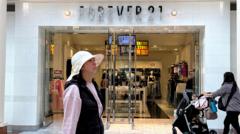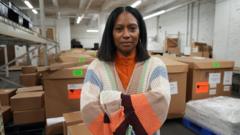As more brands and consumers explore the possibilities of live shopping, the trend shows signs of expanding despite skepticism about its sustainability.
**The Rise of Live Shopping: A New Trend in Retail?**

**The Rise of Live Shopping: A New Trend in Retail?**
Live shopping combines ecommerce and live video, turning traditional buying into an interactive experience that could change retail as we know it.
In recent years, live shopping has emerged as a novel way for brands to engage customers and improve sales, with individuals like Kelsey Krakora leading the charge.
---
Kelsey Krakora, after a stint in the hospitality industry, found her calling in live shopping. She began selling clothes on platforms like Whatnot and Poshmark, utilizing live video to reach buyers more effectively. "My first live show with Poshmark was on November 27, 2022. I sold zero items at first, but that quickly changed," she reflects. Now, her live shows sell around 100 items valued at approximately $1,000 per session, which lasts an average of three hours.
Live shopping, while popular in Asia, is gaining traction in Europe and the US, serving as a digital version of traditional shopping channels like QVC. With a market size reaching $32 billion, sectors such as fashion and cosmetics are leading the way. A recent VTEX survey indicated that 45% of American consumers explored live shopping events in the last year.
Guillaume Faure, CEO of LiveMeUp, noted how platforms such as Instagram and YouTube have propelled live shopping’s popularity, especially with tutorials and interactive content. However, skepticism remains. Analysts like Sucharita Kodali from Forrester Research warn that live shopping may not suit every market, especially the US, where consumers often prefer the tactile experience of in-store shopping.
Additionally, cultural differences impact the effectiveness of live shopping. In China, influencers known as KOLs have established trust and built brands that resonate with consumers, a precedent that may be harder to replicate in Western markets.
Despite challenges, major brands like Nordstrom, Samsung, and L'Oreal have embraced live shopping, showcasing their products in engaging streams. Manish Chandra, CEO of Poshmark, believes this format fosters community and excitement among shoppers.
Brands like the luxury fragrance house Amouage have also recognized the immediate feedback this model provides, allowing them to adapt and innovate faster than traditional surveys.
As live shopping continues to grow, it remains to be seen if it will maintain momentum or fade into a niche marketplace. With both potential and limitations at play, this modern approach to retail may forever change how consumers shop online.
---
Kelsey Krakora, after a stint in the hospitality industry, found her calling in live shopping. She began selling clothes on platforms like Whatnot and Poshmark, utilizing live video to reach buyers more effectively. "My first live show with Poshmark was on November 27, 2022. I sold zero items at first, but that quickly changed," she reflects. Now, her live shows sell around 100 items valued at approximately $1,000 per session, which lasts an average of three hours.
Live shopping, while popular in Asia, is gaining traction in Europe and the US, serving as a digital version of traditional shopping channels like QVC. With a market size reaching $32 billion, sectors such as fashion and cosmetics are leading the way. A recent VTEX survey indicated that 45% of American consumers explored live shopping events in the last year.
Guillaume Faure, CEO of LiveMeUp, noted how platforms such as Instagram and YouTube have propelled live shopping’s popularity, especially with tutorials and interactive content. However, skepticism remains. Analysts like Sucharita Kodali from Forrester Research warn that live shopping may not suit every market, especially the US, where consumers often prefer the tactile experience of in-store shopping.
Additionally, cultural differences impact the effectiveness of live shopping. In China, influencers known as KOLs have established trust and built brands that resonate with consumers, a precedent that may be harder to replicate in Western markets.
Despite challenges, major brands like Nordstrom, Samsung, and L'Oreal have embraced live shopping, showcasing their products in engaging streams. Manish Chandra, CEO of Poshmark, believes this format fosters community and excitement among shoppers.
Brands like the luxury fragrance house Amouage have also recognized the immediate feedback this model provides, allowing them to adapt and innovate faster than traditional surveys.
As live shopping continues to grow, it remains to be seen if it will maintain momentum or fade into a niche marketplace. With both potential and limitations at play, this modern approach to retail may forever change how consumers shop online.














